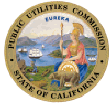 California Public Utilities Commission
California Public Utilities Commission
505 Van Ness Ave., San Francisco
_______________________________________________________________________________
FOR IMMEDIATE RELEASE PRESS RELEASE Media Contact: Terrie Prosper, 415.703.1366, news@cpuc.ca.gov
CPUC SETS STAGE TO CONSIDER PUBLIC GOODS CHARGE FUNDING
SAN FRANCISCO, Oct. 6, 2011 - The California Public Utilities Commission (CPUC) today said it will consider whether and how to continue funding to produce the public benefits associated with the Public Goods Charge in the areas of renewables and research, development, demonstration, and deployment (RD&D), which will expire on Jan. 1, 2012.
In a Sept. 23, 2011, letter to CPUC President Michael R. Peevey, Governor Brown requested that the CPUC take action to ensure that critical clean energy programs, like those supported by the Public Goods Charge, are instituted. In a response letter on Sept. 28, 2011, President Peevey committed to doing all the CPUC can to ensure that the programs funded by the Public Goods Charge continue without pause.
Said President Peevey, "Today the CPUC is taking the first formal step in response to the Governor's request that there be no hiatus in funding the several vital programs that make up the Public Goods Charge and that have helped to make California a world leader in energy research and energy efficiency. I look forward to working collaboratively with other stakeholders and state agencies going forward."
Added Commissioner Catherine J.K. Sandoval, "I support the CPUC's efforts to develop innovative energy efficiency and renewable energy programs that are critical to generating clean energy to power our lives and repower our economy."
This proceeding will have two phases. The first phase will address the appropriate funding levels for the renewables and RD&D purposes, going as far as possible in the short timeframe before Jan. 1, 2012, to specify programmatic objectives and details about how the funds should be used. Phase 1 will also address how those funds, if any, should continue to be collected from ratepayers and for how long. The CPUC expects to issue a Phase 1 decision before Jan. 1, 2012, in order to ensure continuity in funding and collections, if warranted, or a smooth transition to a new funding level, to be determined in Phase 1.
Assuming the CPUC's decision in Phase 1 determines that some level of funding should continue to support the renewables and RD&D goals, in the second phase of the proceeding, the CPUC will address more detailed program design, oversight, and administrative questions related to how the funding will be allocated and by whom.
Beginning with the deregulation of the electricity industry in California in 1996, the concept of a Public Goods Charge was introduced in statute to guarantee funding for activities that may not otherwise be supported during a move toward competitive wholesale and retail markets for electricity. Policymakers reasoned that certain activities and funds needed to be protected as in the public interest, in case individual electricity providers might not find it in their individual economic interests to continue such activities.
The current Public Goods Charge requirements are embodied in Public Utilities Code covering only energy efficiency, renewables, and RD&D activities. Since the inception of the charges, funds have been collected on a volumetric basis from all customers, with a flat fee per kilowatt-hour of electricity usage paid by each customer, with the surcharge level determined by customer class.
Issues related to the expiration of the energy efficiency funding will be handled in the CPUC's ongoing proceedings related to energy efficiency (R.09-11-014).
The proposal voted on is available at http://docs.cpuc.ca.gov/word_pdf/AGENDA_DECISION/144456.pdf.
For more information on the CPUC, please visit www.cpuc.ca.gov.
###
